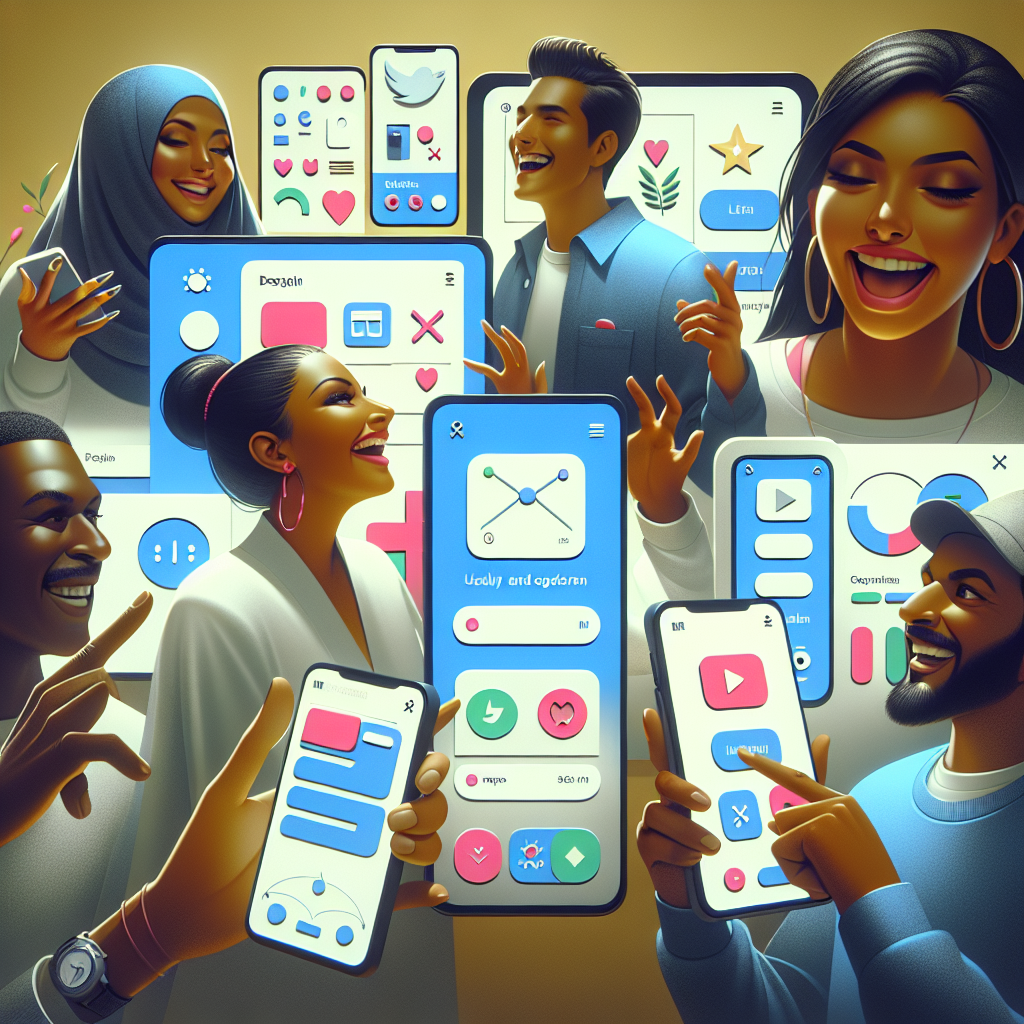In today’s digital landscape, a well-crafted mobile app user experience design is crucial for the success of any application. User experience (UX) encompasses all aspects of the end-users’ interaction with the company, its services, and its products. When it comes to mobile apps, UX design is about creating an intuitive, efficient, and enjoyable experience for the user.
The importance of UX design cannot be overstated. A poor user experience can lead to high abandonment rates, negative reviews, and ultimately, the failure of the app. On the other hand, a stellar UX can increase user engagement, foster loyalty, and drive positive word-of-mouth.
UX design involves several key components including usability, visual design, information architecture, and user testing. Each of these elements plays a vital role in ensuring that users have a seamless and satisfying interaction with your app.
Whether you are a seasoned developer or new to mobile app development, understanding the fundamentals of UX design is essential. Investing time and resources in this area can significantly impact your app’s overall performance and user satisfaction.
Ready to take your mobile app to the next level? Book A Consultation Now! and let us help you create an exceptional user experience for your app.
Importance of User Experience Design

Understanding the importance of user experience design is fundamental to developing a successful mobile app. UX design is more than just a buzzword—it’s a critical component that can make or break your app’s success. Here are key reasons why focusing on UX design is essential:
- User Retention: A well-designed app keeps users engaged and encourages them to return. Poor UX, on the other hand, can lead to frustration and high abandonment rates.
- Increased Conversions: Good UX design simplifies the process for users to complete desired actions, such as making a purchase or signing up, thereby improving conversion rates.
- Brand Loyalty: Providing a seamless and enjoyable user experience builds trust and loyalty. Users are more likely to recommend your app to others if they have positive interactions.
- Competitive Advantage: In a crowded app market, a superior user experience can set your app apart from competitors, making it more attractive to potential users.
- Reduced Development Costs: Investing in UX design early in the development process can help identify and fix usability issues before they become costly problems down the line.
By prioritizing UX design, you not only enhance user satisfaction but also drive better business outcomes. It’s a win-win situation that underscores the critical role of UX in the success of mobile applications.
Key Elements of UX Design

Creating a stellar mobile app user experience design requires a thoughtful approach to several key elements. These core components ensure your app is not only functional but also delightful to use:
- Usability: The app should be easy to navigate, with intuitive controls and clear instructions. Users should be able to complete tasks without confusion or difficulty.
- Accessibility: Make sure your app is accessible to all users, including those with disabilities. This could mean incorporating features like voice commands, larger text options, and high-contrast color schemes.
- Visual Design: A visually appealing app can significantly enhance the user experience. Consistent and attractive visual elements such as icons, typography, and color schemes contribute to a cohesive look and feel.
- Performance: Speed and responsiveness are crucial. An app that lags or crashes frequently will frustrate users and drive them away. Optimize loading times and ensure smooth transitions and interactions.
- Feedback: Users should receive immediate feedback for their actions. Whether it’s a subtle animation or a confirmation message, feedback helps users understand the consequences of their interactions.
- Content: Relevant and engaging content is at the heart of any good UX design. Ensure that your app’s content is valuable, easy to read, and well-organized.
- Personalization: Offering personalized experiences can make users feel valued. This could include personalized content recommendations, user-specific settings, or customized interfaces.
By focusing on these key elements, you can create a mobile app that not only meets user needs but also exceeds their expectations. Prioritizing these aspects will lead to a more effective and enjoyable user experience.
Usability Testing for Mobile Apps
To ensure your mobile app user experience design meets the highest standards, usability testing is an essential step. This process involves evaluating your app with real users to identify any usability issues and gather feedback for improvements. Here are the key steps in conducting effective usability testing:
- Define Objectives: Clearly outline what you aim to achieve with your usability test. Whether it’s testing a specific feature or the overall user flow, having a focused objective will guide your testing process.
- Recruit Test Participants: Select a diverse group of participants that represent your target user base. This ensures that the feedback you receive is relevant and comprehensive.
- Create Test Scenarios: Develop realistic scenarios or tasks that participants will perform during the test. These should align with common user goals and actions within your app.
- Conduct the Test: Facilitate the test sessions, either in-person or remotely, and observe how participants interact with your app. Encourage them to think aloud as they navigate, providing insights into their thought process and any difficulties they encounter.
- Analyze Results: After the testing sessions, compile and analyze the data. Look for patterns and common issues that multiple users faced. This will help you identify the most critical areas for improvement.
- Iterate and Improve: Use the insights gained from the usability test to make necessary adjustments to your app. This may involve redesigning certain features, enhancing navigation, or fixing bugs.
Usability testing is an ongoing process that should be integrated into your development cycle. Regular testing helps ensure that your app remains user-friendly and continues to meet the evolving needs of your users. Investing time and resources in usability testing can significantly enhance your app’s overall success and user satisfaction.
Best Practices for UX Design

Creating an exceptional mobile app user experience design requires adherence to certain best practices. These guidelines help ensure your app is intuitive, engaging, and user-friendly. Below are some of the most effective best practices for UX design:
- Understand Your Users: Conduct thorough user research to understand your target audience’s needs, preferences, and pain points. This information will guide your design decisions and ensure that your app meets user expectations.
- Simplicity is Key: Keep the design simple and uncluttered. Avoid overwhelming users with too much information or too many features. Focus on delivering a clean and straightforward user interface that guides users effortlessly.
- Consistency Matters: Ensure consistency in design elements such as colors, fonts, and icons throughout the app. Consistent design creates a seamless user experience and helps users navigate your app with ease.
- Prioritize Accessibility: Make your app accessible to all users, including those with disabilities. This involves using readable fonts, providing alternative text for images, and ensuring that the app can be navigated using screen readers and other assistive technologies.
- Responsive Design: Design your app to be responsive across different devices and screen sizes. This ensures that users have a consistent and positive experience, whether they are using a smartphone, tablet, or other devices.
- Feedback Mechanisms: Incorporate feedback mechanisms such as notifications, error messages, and confirmations. These help users understand the outcome of their actions and provide guidance when something goes wrong.
- Iterative Testing and Improvement: Regularly test your app with real users and gather feedback. Use this feedback to make iterative improvements to your design, ensuring that your app evolves to meet user needs and expectations.
By following these best practices, you can create a mobile app that not only looks great but also delivers a seamless and enjoyable user experience. A well-designed app fosters user satisfaction, promotes engagement, and ultimately drives success in the competitive mobile app market.
Future Trends in Mobile UX Design

As technology continues to evolve, so do the trends in mobile app user experience design. Staying ahead of these trends can give your app a competitive edge and ensure it meets the ever-changing expectations of users. Here are some key future trends in mobile UX design:
- Voice User Interfaces (VUIs): With the rise of voice-activated assistants like Siri and Alexa, integrating voice user interfaces into mobile apps is becoming increasingly popular. VUIs provide a hands-free experience, making interactions more natural and accessible.
- Augmented Reality (AR): AR is transforming the way users interact with mobile apps by overlaying digital information onto the real world. This technology is particularly impactful in sectors like retail, gaming, and education, where immersive experiences can significantly enhance user engagement.
- Personalization: Users now expect personalized experiences tailored to their preferences and behaviors. Leveraging AI and machine learning, apps can offer customized content, recommendations, and interfaces, thereby increasing user satisfaction and retention.
- Gestural Navigation: As physical buttons continue to disappear from smartphones, gestural navigation is becoming a standard. Designing intuitive gestures for navigation can create a more fluid and engaging user experience.
- Dark Mode: Offering a dark mode option is not just a trend but a necessity. It reduces eye strain, saves battery life, and provides a visually appealing alternative to the traditional light mode.
- Microinteractions: These are small, subtle animations or responses that occur during user interactions, such as a button changing color when pressed. Microinteractions enhance the overall user experience by providing visual feedback and making the app feel more responsive.
- 5G Integration: The rollout of 5G technology promises faster internet speeds and lower latency. This will enable more complex and data-intensive applications, such as real-time augmented reality and high-quality video streaming, to function seamlessly on mobile devices.
Embracing these trends can help you create a forward-thinking, engaging, and user-friendly mobile app. Staying updated with the latest advancements ensures that your app not only meets current user expectations but also sets a benchmark for future developments.
Ready to future-proof your mobile app with cutting-edge UX design? Book A Consultation Now!
